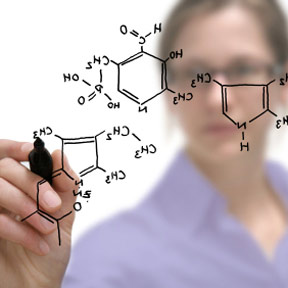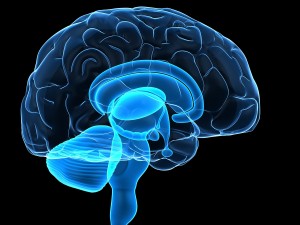5 Herbal Rejuvenatives for the Mind and Memory
 As our population ages, declining mental faculties can take first place on the list of one’s health concerns. Alzheimer's disease and other forms of senile dementia affect some 25 percent of all people over 80.1 Research, though, is revealing Ayurvedic approaches in helping to support the natural strength of the mental faculties.
As our population ages, declining mental faculties can take first place on the list of one’s health concerns. Alzheimer's disease and other forms of senile dementia affect some 25 percent of all people over 80.1 Research, though, is revealing Ayurvedic approaches in helping to support the natural strength of the mental faculties.
Mental Rejuvenation with Ayurveda
Medhya is an Ayurvedic concept that implies intellect, or wisdom. Medhya remedies promote mental development and act as mental rejuvenatives, and they also suggest a mind that is mighty, vigorous and pure.
There are many ways to bring medhya into play in the mind. Anything that promotes the sattva guna can help in our quest, and the yamas and niyamas of Patanjali are aimed at this. Ayurvedic herbal medicines also play a role. They engender and summon intelligence, memory and mental perception. They make the mind worthy of sacrifice to higher consciousness.
Bitter taste is made from air and space energies, and these forces predominate in the mind. Bitter foods and herbs open the mind, increase sensitivity, awareness and mental functioning. Since bitter herbs are cooling and calming they combat mental dullness, allowing us to reach our full potential, becoming radiant and elevated.
Mind supplements include a large array of herbs and foods recommended to rebuild body tissues and restore lubricating juices.2 Five of these mind-nourishing herbs stand out as pillars of an Ayurvedic lifestyle.
Ashwagandha
Ashwagandha, sometimes named “winter cherry” or “Withania”, is a top mental rejuvenator. Ayurvedic herbalists use the herb to reestablish long-term sleep rhythms. Ayurvedic herbalism also uses ashwagandha for general strength for support in times of occasional fatigue and exhaustion; and to support healthy memory and a strong nervous system.
This tonic herb, a relative of tomatoes and potatoes, is not stimulating, but rather relaxing. That allows one to use this in larger amounts on a regular basis without concern for overstimulation, so this root is a superb remedy for nervous system support.
Study after study continues to confirm the benefits of this herb on stress tolerance, performance and endurance.3,4,5 One study indicated that the herb supported the brain in times of stress.6 In another, ashwagandha was shown to support strength and physical working capacity.7,8
Ayurveda considers it a “grounding” herb, one that nourishes and regulates metabolic processes and supports a naturally balanced mood. Ashwagandha also supports memory, helping those such as students for whom learning and testing are priorities.9 One recent study looked at sleep and stress. Ashwagandha was effective in supporting naturally healthy sleep patterns.10
As well as being a slow-acting tonic herb, ashwagandha is a superb herb for balancing elevated vata, a common problem as age advances. It takes about a week to work up to an appropriate amount, and about another week for the herb to reach maximum effectiveness. Since ashwagandha is a slow-acting herb, you may take your daily serving at any time during the day.
A typical serving of ashwagandha is about a gram per day, taken over long periods, up to many years, as a rejuvenator, but, since ashwaganda is very safe, larger quantities are often used short term. In India, Withania is given with pungent, heating herbs (ginger, pepper, etc.) to ensure that it gets sufficiently digested.
Calamus
Conscious communication is the essence of yoga. From your chakras to your nervous system to the words you speak, your very molecules are vibrating with the energy of your being, and transmitting that energy to all the other parts of our bodies and to people in your life.
Yoga exercises, pranayama and lifestyle practices all support conscious communication, and there is one special herb that yoga reveres above all others for clarifying and expanding that special spiritual voice we all share.
Calamus root is a major herb for the mind and meditation, and is highly revered by yogis. Though it is not clearly allowed for internal consumption in the US, it can be used topically, either as a dry powder, paste, or as part of an herbalized oil. As a historical and international perspective, ancient yogis and seers used this herb, and it was said to stimulate the power of self-expression and to enhance intelligence. Calamus historically was used to promote a healthy brain, sharpen memory, enhance awareness and increase communication and self-expression. The yogic name, Vacha, means “speech”, referring to its action on the fifth chakra and is propensity to help you speak from your highest consciousness.
This herb was often combined with gotu kola, which is cooling and mild. The complementary energetics made the combination suitable for a wide variety of people. To support attention and focus, it was combined with gotu kola, shankpushpi and licorice. Over the long term, calamus warms the body and pacifies the mind. Vacha was also combined with triphala as a general rejuvenative that bestows intelligence, longevity and good memory.11
Vacha has a long and very special history in Ayurveda. For meditating yogis, it was quite a boost.
Brahmi (Gotu Kola)
Thinking about thinking? Feel like you’re about to max out your personal hard drive? Gotu kola is an herb with a long history of brain support. Gotu kola, also called Mandukaparni, is a mainstay of herbal medicine in Ayurveda. Widely considered a superior herb for the nervous system, gotu kola has a host of benefits.12
In Ayurvedic medicine, this herb is called “brahmi”, which means “godlike”, a reference to its support of graceful aging and to its use as an aid to meditation. It has a bitter taste and is cooling to the body.
Gotu kola supports healthy memory, concentration and intelligence, as well as the voice, physical strength and the complexion.
Gotu kola is a jungle creeper that grows in hot moist climates. After all, it’s the food of the elephants, and we all know about their memories! Fresh, it’s a delicious salad vegetable. The juice of the fresh leaves is available at some juice bars.
More recently, a study out of Korea shows that components in gotu kola show potential for supporting healthy memory, a very promising direction.13
Since gotu kola is basically a mild salad vegetable, the serving can be a larger quantity. Try one to four teaspoonfuls of fresh juice every morning. Many people use a modest amount of 1 gram per day in capsules or tablets for daily rejuvenation. Try a cup of gotu kola tea with honey before meditation.
Brahmi (Bacopa)
Water hyssop (Bacopa monniera), also refered to as brahmi in certain parts of India, is a steadfast mainstay of traditional Ayurvedic medicine. An indication of the respect for this herb is the name: “brahmi” means “god-like”. It’s used in Asia for support of the nervous system, mental energy, and healthy memory—it’s a powerful brain food. Meditators use it to increase comprehension, concentration and recollection. Because it traditionally supports a person’s natural ability to solve problems effectively, it is often found in Ayurvedic formulas to cope with stress.
With nearly 300 studies in the scientific literature, it has built up a solid base of scientific support for its many functions.
In support of the traditional use for promoting healthy memory, Australian researchers recently gave Bacopa to seventy-six adults, aged 40 to 65 years, in a double-blind randomized, placebo control study in which various memory functions were tested. Numerous memory tests before and after taking the brahmi showed that the herb significantly supported the learning process.14
Brahmi has traditionally been used for children as well. Indian schoolchildren take it at home. In 1987, Indian scientists gave brahmi to 40 schoolchildren aged 6-8 in a single-blind trial. The study showed support of learning, memory and perception. The dose was 1 gram per day for three months, of the dried plant extracted into a syrup form, and no side effects were recorded.15
The traditional serving can be up to two grams of the whole herb, in capsules, tablets or tea, twice a day with warm water.
Shankhapushpi
When we need mental peace and sleep, we may call upon shankhapushi to help restore clear quality of the mind and relaxation. Its flowers resemble the shankha or conch shell, thus the name. It usually is a foot tall plant, with dome of flowers, in open fields in North India.
This herb is an outstanding rejuvenative tonic for the mind and nerve tissue. The plant is said to have profound mystical properties, with an affinity for the heart, throat, third eye and crown chakras.
The herb is especially effective for mental peace and tranquility. Often taken with or prepared in ghee, it promotes serenity without dulling the mind. As it is balancing, its effect can be both uplifting and calming. Students traditionally use it to support a calm mind during exams. For support of focus and attention, it combines well with brahmi and licorice. For support of healthy sleep patterns, use shankpushpi at bedtime (traditional use allows for up to 6 grams). According to the Astanga Hridyam, ghee, cooked three times with shankpushpi juice and milk, makes even the dullest mind sharp.
Ayurveda places special attention on the health of the mind, and fundamentally teaches that, ultimately, all physical imbalances start in the mind, so a healthy mind is at the forefront of Ayurvedic practices. These five herbs form the core of a superb mental rejuvenative chest. They are waiting to help us stay calm, centered, intelligent and exalted, so now might just be the time to give this collection of herbs a try.
Karta Purkh Singh Khalsa
Karta Purkh Singh Khalsa is the lead instructor of the nutritional therapy and professional herbalist training programs at Portland Community College, where students pursue their credential online or in classrooms study, and on the founding faculty of Bastyr University Department of Ayurvedic Sciences. Khalsa is the President of the American Herbalists Guild and on the board of directors of the National Ayurvedic Medical Association. He is the first person to be board certified in herbalism and Ayurveda.
http://www.pcc.edu/climb/health/
http://www.kpkhalsa.com/
http://www.internationalintegrative.com/
References
Jill Stansbury, N.D., Sustain the Brain, Nutrition Science News, February, 2001, http://www.healthwellexchange.com/
Sharma, Ram, and Dash, Bhagwan, Caraka Samhita, Chowkhamba, Varanasi, 1992
Archana R, Namasivayam A. Antistressor effect of Withania somnifera. J Ethnopharmacol 1999 Jan;64(1):91-3
Singh B, Saxena AK, Chandan BK, Gupta DK, Bhutani KK, Anand KK. Adaptogenic activity of a novel, withanolide-free aqueous fraction from the roots of Withania somnifera Dun. Phytother Res 2001 Jun;15(4):311-318
Venkatraghavan S, et al, J Res Ayu Sid, 1, 1980:370. [from: Bone K, “Withania somnifera”, Clinical Applications of Ayurvedic and Chinese Herbs, (Queensland, Australia: Phytotherapy Press), 1996:137-41.]
Jain S, Shukla SD, Sharma K, Bhatnagar M. Neuroprotective Effects of Withania somnifera Dunn. in Hippocampal Sub-regions of Female Albino Rat. Phytother Res 2001 Sep;15(6):544-548
Dhuley JN. Adaptogenic and cardioprotective action of ashwagandha in rats and frogs. J Ethnopharmacol 2000 Apr;70(1):57-63
Bhattacharya SK, Bhattacharya A, Chakrabarti A. Adaptogenic activity of Siotone, a polyherbal formulation of Ayurvedic rasayanas. Indian J Exp Biol 2000 Feb;38(2):119-28
Dhuley JN. Nootropic-like effect of ashwagandha (Withania somnifera L.) in mice. Phytother Res 2001 Sep;15(6):524-528
Kumar A, Kalonia H. Effect of Withania somnifera on Sleep-Wake Cycle in Sleep-Disturbed Rats: Possible GABAergic Mechanism. Indian J Pharm Sci. 2008 Nov;70(6):806-10.
Srikantha Murthy, K.R. Vagbhata’s Astanga Hrdayam. vol. 3. Varanasi: Krishnadas Academy. 1995. p. 387
Vaidya, Ashok D.B. The Status And Scope Of Indian Medicinal Plants Acting On Central Nervous System. Indian J Pharmacol 1997; 29: S340-S343
Mook-Jung I, Shin JE, Yun SH, Huh K, Koh JY, Park HK, Jew SS, Jung MW. Protective effects of asiaticoside derivatives against beta-amyloid neurotoxicity. J Neurosci Res 1999; Nov 1;58(3):417-25
Roodenrys S1, Booth D, Bulzomi S, Phipps A, Micallef C, Smoker J . Chronic effects of Brahmi (Bacopa monnieri) on human memory. Neuropsychopharmacology. 2002 Aug;27(2):279-81
Sharma R, Chaturvedi C, Tewari PV. Efficacy of Bacopa monniera in revitalizing intellectual functions in children. J Res Edu Indian Med. 1987;1:12
Read More
Cold Hands Cold Feet
 I was driving into the office the other day and became aware of cold hands. They had been warm before I had left the house so there had been a change. "What's going on," I asked myself, but of course I knew that I had made this observation in the past.
I was driving into the office the other day and became aware of cold hands. They had been warm before I had left the house so there had been a change. "What's going on," I asked myself, but of course I knew that I had made this observation in the past.
But this time I began to put it together. As we have discussed in previous blog posts, the biological energy field expresses itself through qualities of sensation. There are 10 biological pairs of sensation. For example, the sensations of hot and cold, light and heavy, subtle and gross are examples of these paired potential sensations.
We can only know the energy body through sensations in the mindbody. So when I felt the cold hands it occurred to me that the biological energy pattern of Vata, the priniciple of movement in the physiology, must be being aggravated. It was subtle but real and a tip off to slow down and breath. When we get into a rush, we invoke the sympathetic nervous system and from a matter field perspective, we vasoconstrict and this reduces blood flow to the hands.
From an energy perspective, the energy field was sending me a signal to slow down and breath which would activate the parasympathetic nervous system and restore balance in the energy physiology.
Foods can produce the same shifts in the energy mindbody. Have you ever felt hot after eating a very spicy meal? This is yet another message from the energy field. All we have to do is pay attention.
To good health DrBill
Read More
Molecular Medical Science and Chronic Disease
 Hmmm a question to ponder. Can it be that the current dietary recommendations by our nutritional gurus are actually making us sicker? I believe this is the case.
Hmmm a question to ponder. Can it be that the current dietary recommendations by our nutritional gurus are actually making us sicker? I believe this is the case.
If our current system of nutritional recommendations is so hot, why do we see people such as Oprah struggling with weight control along with millions of others?
Time to re-evaluate, eh? There is no question that our molecular prowess has given us important information but the molecular scheme is outmoded for our biological understanding in the 21st century.
Can inappropriate and indiscriminate supplements make us sick? You bet.
So what's a confused and bewildered consumer supposed to do? Try an energy science approach to not only nutrition but to healing. Now that's empowerment.
Here's a list that should be part of a nutritional system. Notice I said system, I didnt say molecules.
Following nutritional guidelines for energy mindbody constitution
Avoiding incompatible food combinations
Following the five interrogatories of nutrition
Establish healthy rituals around nutrition
Establish a balanced healthy digestive fire
Monitor bowel function and establish healthy patterns
Use yoga nidra to uproot unhealthy habituated lifestyle patterns
This is an energy science approach to nutrition. It requires a paradigm shift from our molecular matter science approach. As has been said, "How's it workin' for ya?", perhaps provides some impetus.
To balance and healthy nutrition Cheers! Love DrBill
Read More
7 Solutions for Psychological Problems
 "I'm anxious about this upcoming project," Mary related "And it seems like the more I do, the farther behind I get On top of it all, there are these things that are coming up at home, with Don and his job I'm just feeling overwhelmed"
"I'm anxious about this upcoming project," Mary related "And it seems like the more I do, the farther behind I get On top of it all, there are these things that are coming up at home, with Don and his job I'm just feeling overwhelmed"
I think many of can relate to Mary's issue of anxiety We've all experienced it in some form or another in doing life But the issue is how to manage it
There is not a water shortage of antidepressants! Even though our current molecular model would lead us to believe that there is some form of molecule shortage in the body, it often falls short of fixing the problem
What's the compelling evidence for that statement Just ask those who have tried this molecular approach this question, "Feeling at the top of your game since you started the medication?"
The reason that pharma can't solve these psychological problems is that it is working with the wrong model The mindbody is a complex matter and energy field but from an energy science view it is first and foremost an energy field Both the physical body and the mind are energy fields
Herein lies the importance of the energy model The common denominator for the mind and body is that they are both energy fields Most of the time the solution to a psychological problem is an energetic one, not a molecular one
Why? The mind is first an energy field and second a molecular field just as the body is first a molecular field and second an energy field
So would you use a screwdriver to drive a nail into wood? In other words, would you use a molecule to solve energetic dissonance or lack of energetic resonance? Yes you might get lucky but playing the odds, it's probably more likely, better results will occur with an energy solution
Some energetic solutions
Eat according to your mindbody makeup
Avoid poor food combinations see foodsheal.com
Look into yoga and do it daily
Consider meditation
Focus on the breath
Consider yoga nidra
Consider panchakarma
Are you bothered by depression? Anxiety? Are medications not working?
Until tomorrow To health as a Skill Love DrBill
Send a comment?
Read More




